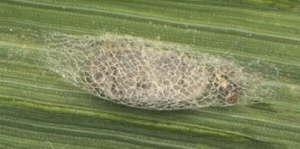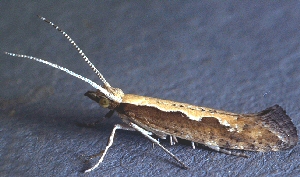Diamondback Moth
 Scientific Name
Scientific Name
Plutella xylostella
Host
The diamondback moth is a pest of practically all crucifers, including cabbage, broccoli, cauliflower, collards, kale, brussels sprouts, kohlrabi, turnip, radish, mustard, and watercress.
Symptoms
 Larvae feed on all plant parts, but prefer the undersides of older leaves, crevices
between loose leaves, and young buds. They eat small holes in leaves and buds, or
feed superficially leaving slight perforations instead of distinct holes completely
through the leaf. When populations remain low, these small caterpillars cause little
damage; however, in large numbers, they may be injurious to young plants. Heavy feeding
on buds may cause the marketable portion of the plant to fail to develop property.
Larvae feed on all plant parts, but prefer the undersides of older leaves, crevices
between loose leaves, and young buds. They eat small holes in leaves and buds, or
feed superficially leaving slight perforations instead of distinct holes completely
through the leaf. When populations remain low, these small caterpillars cause little
damage; however, in large numbers, they may be injurious to young plants. Heavy feeding
on buds may cause the marketable portion of the plant to fail to develop property.
Life Cycle
 Diamondback moths overwinter as adults among field debris of cruciferous crops. Active
adults may be seen during warm periods any time in the winter. In spring, eggs are
laid, singly or in groups of two or three on foliage. Larvae hatch a few days later,
usually by early April in Oklahoma. Larvae feed for about 10 days during warm weather
or for as much as a month during cool seasons. They first feed as leafminers but soon
emerge and infest the undersides of the leaves. When mature, larvae spin loose cocoons
which remain attached to lower leaf surfaces. After a two-week pupal period, a new
generation of moths emerges. Activity can continue through October and even into mid-November.
There are thought to be five or six generations per year in Oklahoma.
Diamondback moths overwinter as adults among field debris of cruciferous crops. Active
adults may be seen during warm periods any time in the winter. In spring, eggs are
laid, singly or in groups of two or three on foliage. Larvae hatch a few days later,
usually by early April in Oklahoma. Larvae feed for about 10 days during warm weather
or for as much as a month during cool seasons. They first feed as leafminers but soon
emerge and infest the undersides of the leaves. When mature, larvae spin loose cocoons
which remain attached to lower leaf surfaces. After a two-week pupal period, a new
generation of moths emerges. Activity can continue through October and even into mid-November.
There are thought to be five or six generations per year in Oklahoma.
Description
This small, grayish brown moth has narrow front wings, conspicuously fringed hind wings, and a wingspread of about 3/ 4 inch. When at rest, the wings come together to form a line of white or pale yellow diamonds down the middle of the back. The minute, round eggs are pale yellow. The larvae are slightly tapered at each end and pale green in color. They have black heads and scattered black hairs on the body. At the rear end of the larva, the prolegs on the last segment are spread apart, forming a characteristic "V" shape. They are slightly over 1/4 inch long at maturity and wriggle rapidly if disturbed. The yellowish pupae are enclosed in loosely spun, gauzelike cocoons.
Control
Please contact your local county extension office for current information.
